Preimplantation genetic testing (PGT) is a screening and diagnostic tool that, when used in conjunction with in vitro fertilization (IVF), can greatly increase the rate of IVF success.


PGT is a reproductive technology comprised of three DNA based tests used in concert with IVF cycles to increase the potential for a healthy and successful pregnancy and delivery. This set of PGT tests is used (1) to determine that an embryo has the correct chromosomal content prior to transfer, avoiding embryos with chromosomal gains or losses called aneuploidy, (2) to detect inherited single-gene disorders, or (3) to detect structural chromosome rearrangements such as unbalanced translocations.
PGT for monogenic (single-gene) disorders (PGT-M) is used with an IVF cycle for at-risk couples to determine that an embryo does not contain an inherited genetic disorder; thus, ensuring the disorder is not passed on to children.
PGT for aneuploidy (PGT-A) determines if an embryo has the correct number of chromosomes prior to uterine implantation. For couples undergoing IVF, it can significantly increase the chance of a pregnancy and birth of a healthy child.
PGT for structural rearrangements (PGT-SR) is used with an IVF cycle for couples that carry structural chromosome rearrangements called translocations. It can identify embryos for transfer that contain balanced chromosome content.
The authors of this review published in the International Journal of Molecular Sciences provide a comprehensive and detailed discussion of the PGT process covering the key steps from embryo biopsy to molecular methods used for embryo analysis to maternal and neonatal outcomes.

Looking for more information on PGT at Fairfax Diagnostics? Here are some frequently asked questions.
To appreciate how PGT can be helpful to couples it is important to understand chromosomes. Chromosomes are the physical structures made of DNA that contain the genes necessary for development. Chromosomes are located in the center of the cell, in the area called the nucleus. A normal human cell should contain exactly 46 chromosomes. There are 23 pairs of chromosomes. The first 22 pairs are identified by number and organized by size. The 23rd pair, the sex chromosomes, determines gender. Females have two of the same sex chromosome, called the X chromosome, while men have two different sex chromosomes, known as the X and Y chromosomes. A normal set of chromosomes is 46, XX for a female and 46, XY for a male. In a normal conception, both the egg and sperm cells should contribute exactly 23 individual chromosomes, one of each of the 22 numbered pairs (called autosomes) and one of the sex chromosome pair. When an egg with 23 chromosomes fuses with a sperm with 23 chromosomes, the correct chromosome number of 46 (23 pairs) is again present, and the fertilized embryo has the best possible chance of developing appropriately. When an egg or sperm cell divides improperly as it is developing, the mature egg or sperm may contain more or less than 23 chromosomes. If this egg or sperm is used for fertilization, the resulting embryo will not contain exactly 46 chromosomes, but more or less than 46, known as aneuploidy.
Embryos created using standard IVF protocols with intracytoplasmic sperm injection (ICSI) are grown in the laboratory for 5 to 6 days until they form an early embryo called a blastocyst. The embryo is subsequently biopsied to remove a few cells from the outer layer, also called a trophectoderm, which is destined to form the placenta.
After biopsy, embryos are frozen and stored while the cell’s genetic material is tested for abnormalities using PGT. After PGT analysis, results are evaluated by the medical and genetics teams, then a FAIRFAX DIAGNOSTICS genetic counselor will discuss results with the patient/couple and a frozen embryo transfer (FET) cycle is planned for the healthy embryo(s).
For couples pursuing testing for aneuploidy (PGT-A) and structural chromosome rearrangements (PGT-SR), a method called Next Generation Sequencing (NGS) is used. This technology determines the amount of DNA present for each chromosome in cells removed from the developing embryo. Gains or losses of complete chromosomes or parts of chromosomes are identified by NGS and a dedicated software algorithm. For gender determination, NGS testing can determine the presence the sex chromosomes, XX or XY, for females or males respectively.
Yes. Substantial data indicates that PGT does not increase birth defects over that of the general population. Removal of a few cells from the outer layer (trophectoderm) does not alter the ability of that embryo to develop a normal pregnancy; in fact, biopsy avoids disrupting the embryo’s inner most cells that will form the fetus. In embryos undergoing PGT testing, many fewer pregnancies will end in miscarriages due to chromosomal disorders since abnormalities are identified prior to embryo transfer.
Fairfax Diagnostics requires counseling for all PGT-M and -SR patients. We also recommend consultation for PGT-A.
Due to the complexity of testing for these genetic disorders, patients should have a full consultation with a medical geneticist or genetic counselor to determine if this option would fit their family’s needs. To schedule a telephone consultation, click the link below.
To get started with PGT at Fairfax Diagnostics contact us today.
